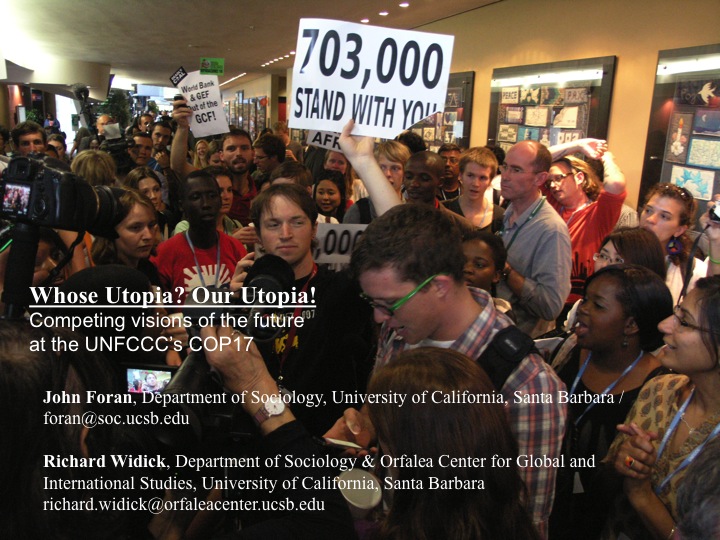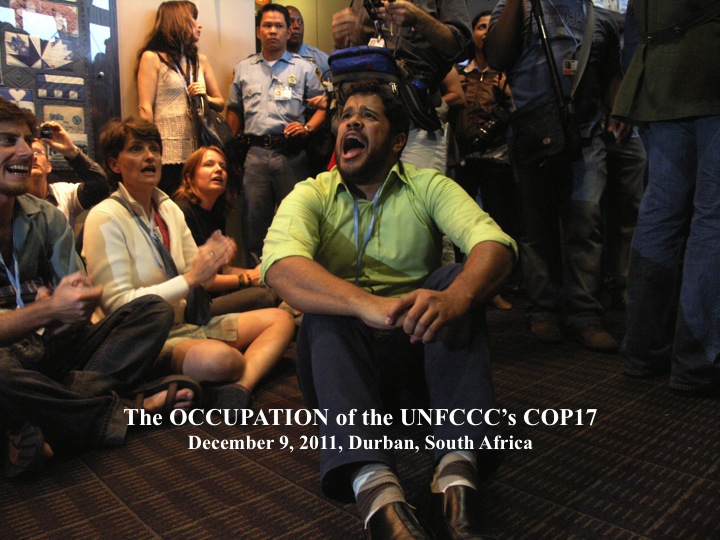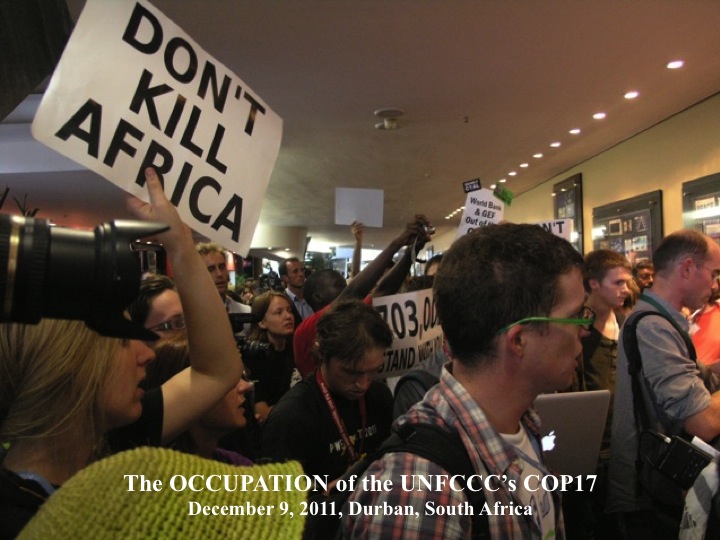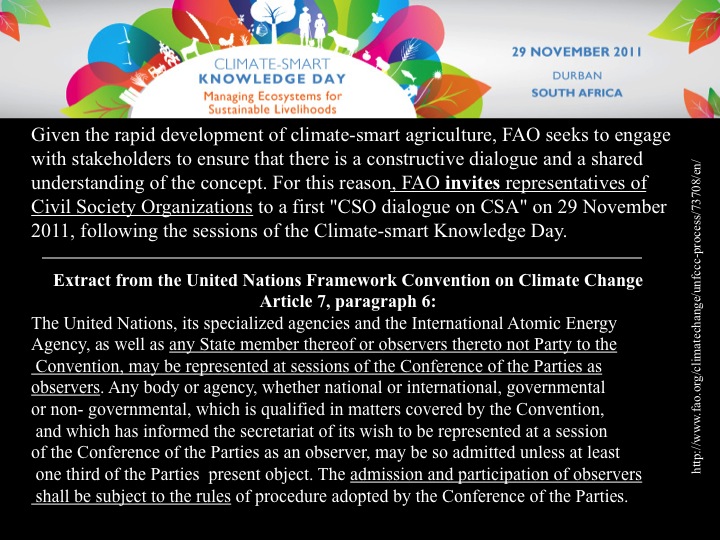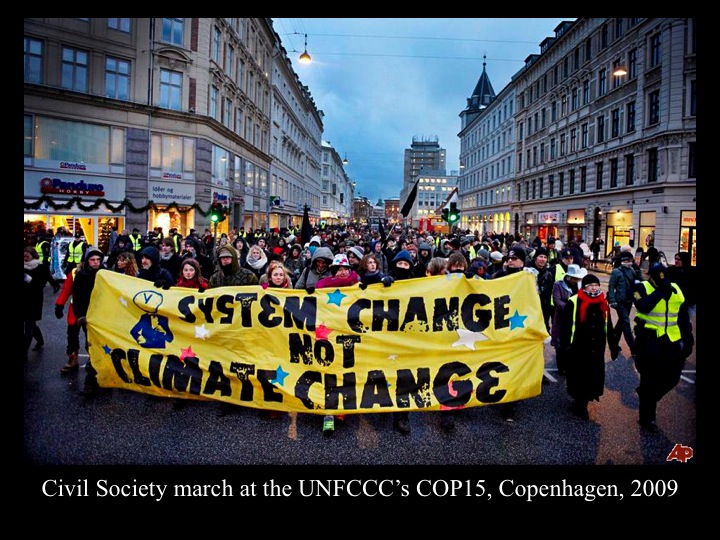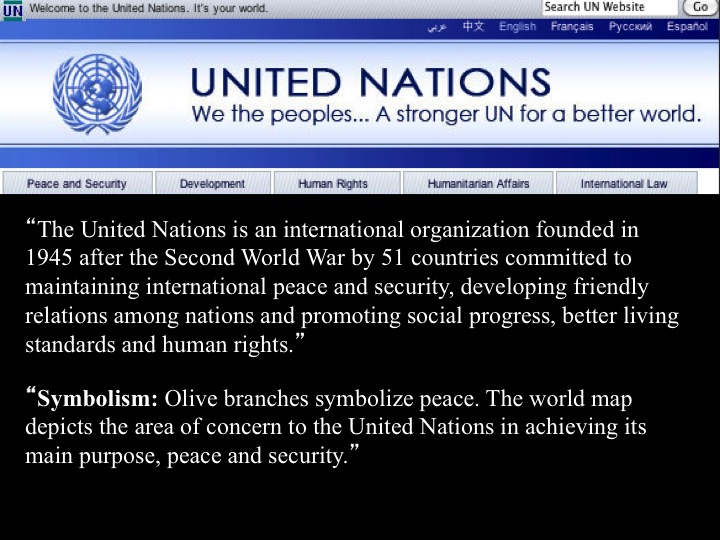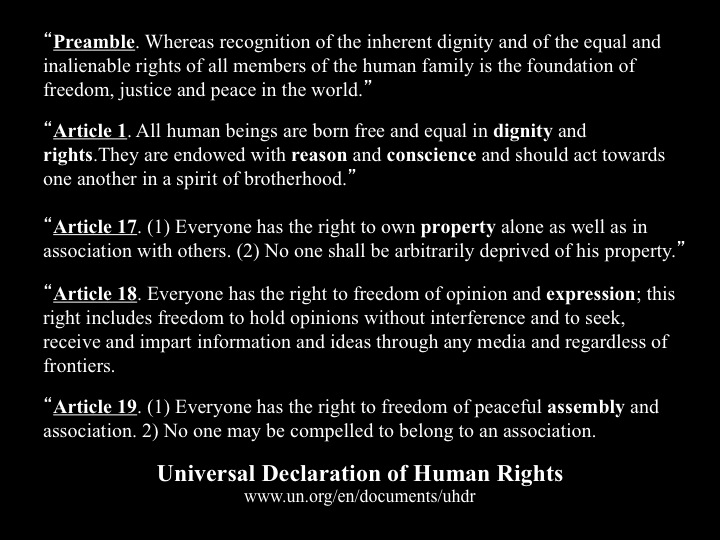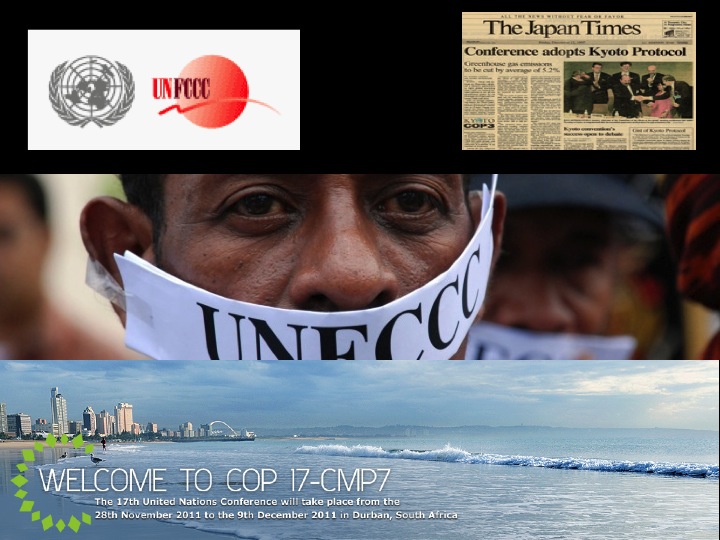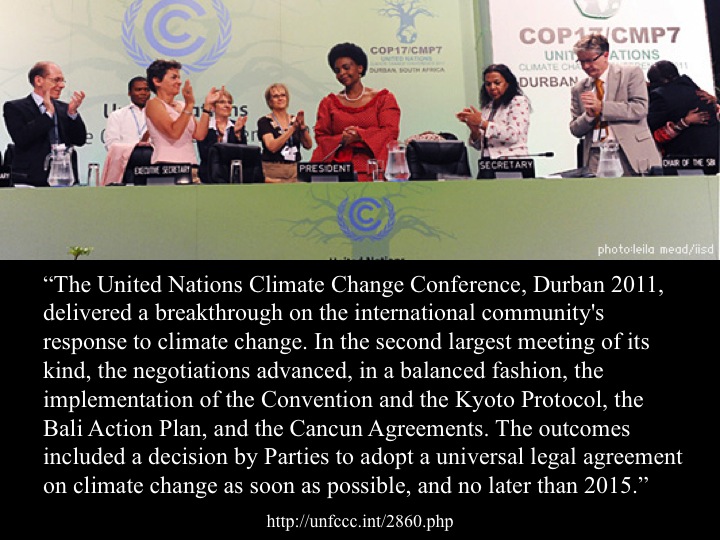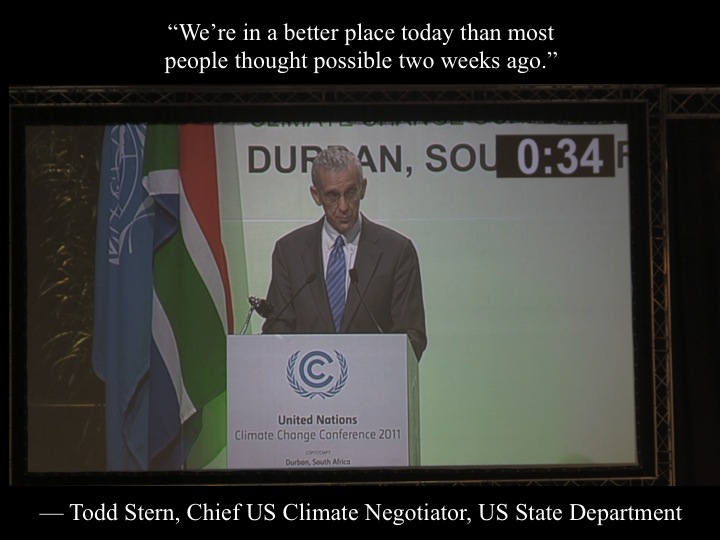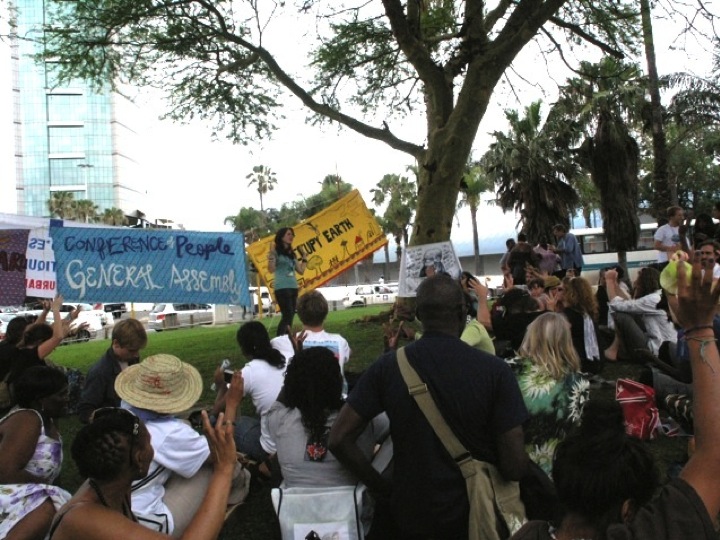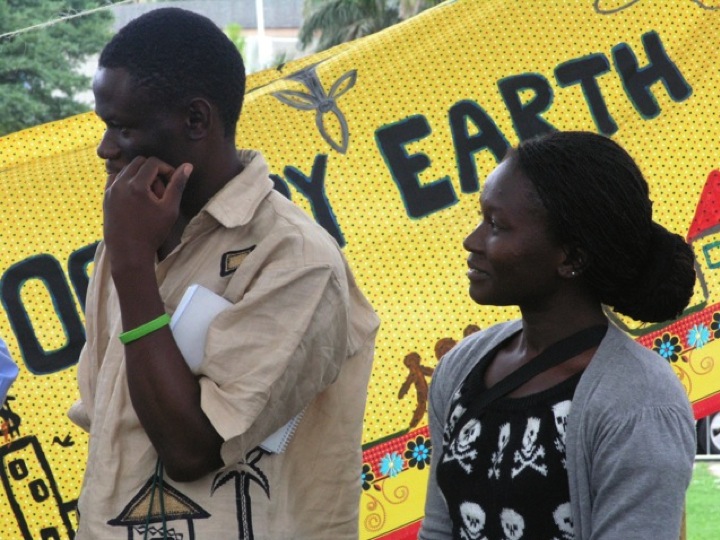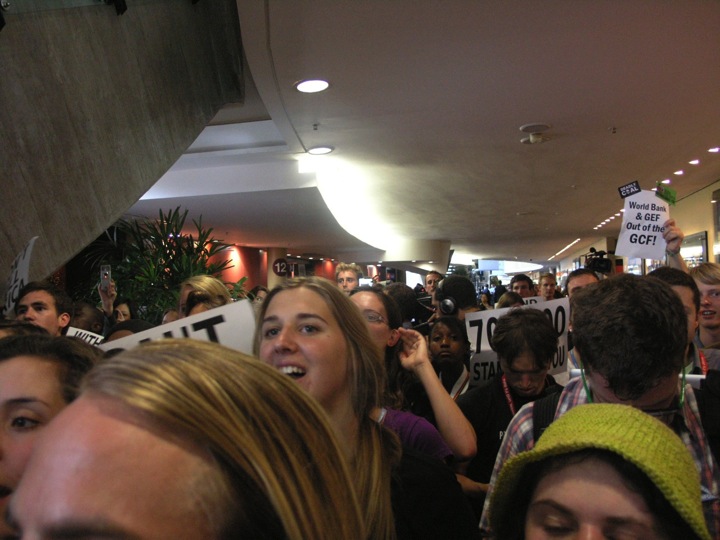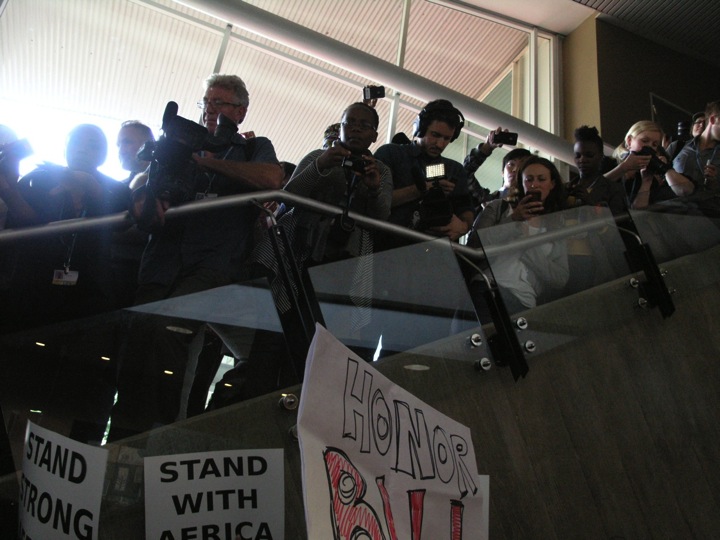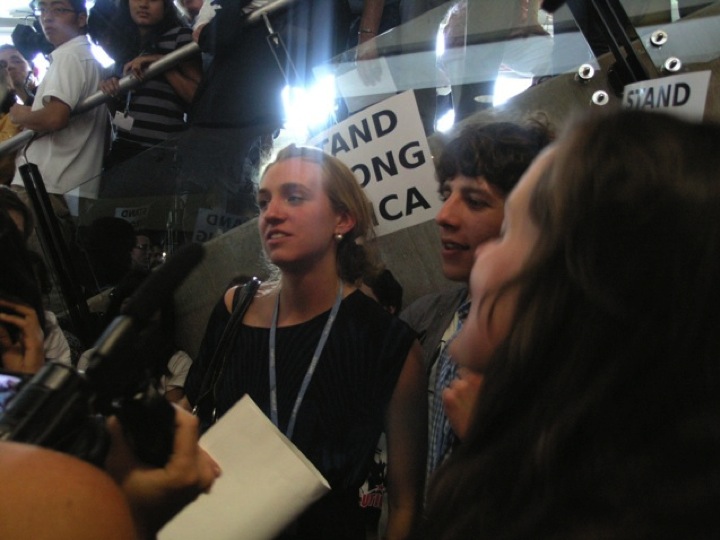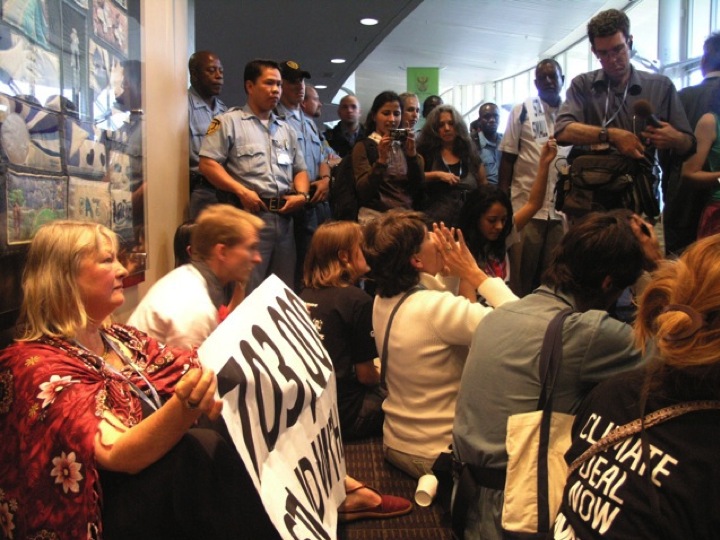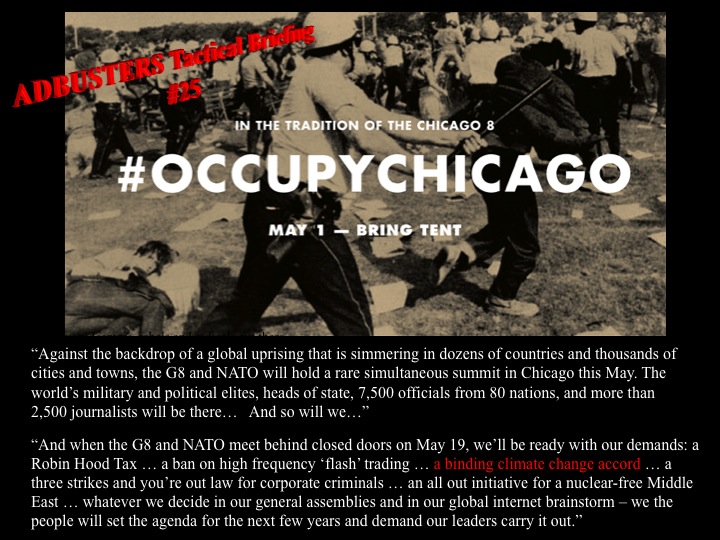“Whose Utopia? Our Utopia! Competing Visions of the Future at the UN Climate Talks” (Foran & Widick, 2016)
Nature and Culture 11(3), Winter 2016: 296–321
— scroll down to see the original draft with photos and notes —
Whose Utopia? — Our Utopia!
Competing visions of the future at the UNFCCC’s COP17
[NOTE: what follows is an early version of our Winter, 2016 article in Nature & Culture 11(3): 296-321]
John Foran, Department of Sociology, UC Santa Barbara / foran@soc.ucsb,.edu
Richard Widick, Orfalea Center for Global and International Studies, UC Santa Barbara / richard.widick@orfaleacenter.ucsb,edu
This paper was first presented on March 1, 2012 at UCSB’s SYMPOSIUM: Beyond Utopia: Crisis, Values and the Socialities of Nature.
___________________________________________
They say we are dreamers… but actually, we are the awakening.
—Slavoj Zizek, at Zucotti Park with Occupy Wall Street
If our title is going to be meaningful, it’s going to be a complex meaning, for the word utopia is in itself complex. Originally from the Greek “ou” for not, or no; and topos, the word for “place”, combined to mean no place… and thus no actually existing place; the English apparently adopted the same sounding Greek root of “eu” meaning for good, or well… thus giving us a word for the good place that is sadly no place at all… That is one way to understand the term. It has become a synonym for the impossible. The obligatory reference is of course to Thomas More’s book of that title published in the year 1535, but the basic meaning now refers to any impossible country or society or community with perfect laws and social conditions. The result is that the word now is often tantamount to a slur.
With this definition, it might be said that the global climate justice movement’s call for a just and binding treaty limiting CO2 is utopian, because it is impossible to achieve given current social conditions—namely, the condition of carbon-fueled industrial modernity.
But thankfully human beings have never been happy or able to live within their means or be satisfied with what appears to be possible at any given moment; consciousness disturbs the universe, as I like to put it. Hegel, perhaps put it best in the Phenomenology, but here I cite Kojève from his Introduction to the Reading of Hegel: “Desire is what transforms being” (and this is specially relevant for the reflexive contemplation of the self by the self)[i]
Being is what is, in itself; but human being is not merely in itself, but for itself. And thus, taking itself as an object, with that knowledge of self it necessarily transforms itself, for there is “no naming of a thing that is not a further shaping of that thing,” as Judith Butler conveyed so precisely in Bodies that Matter. Knowledge of self therefore transforms the self—and thus human being does not submit to the real conditions of its existence; rather, its desire channels its attention through labor into nature and transforms itself, the world, and the future, for better or for worse, and too often the worst comes about in the form of unintended consequences.
The so-called Greco-Euro-Anglo-American Enlightenment, which for hundreds of years has and still does continuously apply science to everything, including politics and society and especially capitalism—this scientific turn is an historical process that has done much in the way of liberating human kind from the chaos and brutality of nature.
That is of one of the most important consequences of scientific capitalism—its production of wealth and innovation that improves and lengthens lives. With Marx we take note of the fact that capitalism has produced more wealth than previously imaginable. But that is not all it did. In its myriad historical processes of self-constitution it has also created the greatest of human miseries.
Here we affirm our belief that the scarcity we have all around us, the poverty and famine, the ill-health, illiteracy, and the suffering of multitudes in general from every form of deprivation—our belief is that this scarcity is artificial.
And so, sadly, in conquering nature the great societies of scientific modernity are now forced to rediscover anew the law of unintended consequences.
And because of that capitalism had a hand in producing socialism, or at least the social conditions under which it made sense for socialism to construct itself as resistance to the unfettered capitalist production of the misery of workers; and then, as capitalism, checked but not stopped by socialism, regularly shook with crisis, it produced communist revolutions—and we all know how those turned out—they in turn provoked the 20th fascist reactions. In the annals of western history, the trajectory has been first capitalist revolution; then socialist counter-movements and ultimately communist revolutions; and finally the fascist reactions to communism.
Now capitalist growth to infinity is confronting the specter of its unintended environmental consequences as they accumulate in, for example, global warming and climate change. Thus we begin to learn to see that the ultimate system of unintended consequences—we can call it the climate chaos system—is the result of an economic system within which a principal motivating and driving structural force is the externalization of production cost. If an enterprise can find a way to appropriate value from nature without paying the full environmental or social cost, well that is a source of profit. Simply put—avoided cost is profit, and that is a principal structural source of what John Bellamy Foster, Richard York, and Brett Clark call capitalism’s “ecological rift” (The Ecological Rift: Capitalism’s War on the Earth, Monthly Review Press: 2010).
But as those authors point out, in addition to climate change there are other severe ecological rifts equally driven by the structural incentive to avoid cost and that will also, in time, require the same universal response as climate change does now, because their consequences will be equally horrific and global. I speak of oceanic acidification; the disruption of the nitrogen and phosphorus cycles; the destruction of fresh air and water and land and soil for agriculture, and finally the crisis of collapsing biodiversity.
Speaking of scientific capitalism like this means understanding its institutional context. We discover it everywhere coupled with free speech public spheres and democratic polity, in every variety of constitutional state, each one a little different but all afloat on a surging sea of rights discourse—that special way of claiming power for individual entities, from the isolated person all the way up to the nations that shelter them and these days even the corporations claim and often gain legal individual rights of personhood.
To avoid misunderstanding, consider that even China and a great many variously autocratic states and administrations fit this description just as well—they do not and cannot exist in a semiotic vacuum, their political economic and public cultures too are awash in the sea of rights discourse. Maybe they are trying to build sea walls. Maybe they are manning the sea walls with guns. But even if they exclude the talk of this or that right for this or that entity, we know that exclusion is itself constitutive of whatever they are becoming, at least to some extent. Dialectically we know that what China is not also constitutes its meaning and its place in the world order.
This is one way of thinking the historical force of modern western Euro-Anglo-American modernity in semiotic terms—as the revolutionary diffusion of a meaning-making system that people can and do use, for whatever purpose.
We understand the noun modernity by means of the qualified verb—reflexive modernization. As knowledge of climate change and the other ecological rifts grows more certain, civil society conjures up new ecological and social justice movements that disabuse the status quo of the pretension to business as usual. And therefore whatever we learn about the current rise of the global climate justice movement—and by extension the whole of emergent global civil society, which must be understood in the same fashion—by studying its auto-poetic self-conjuring act at events like the annual UNFCCC’s international climate negotiations, will also be applicable to future international regimes of emergent environmental self-governance that will necessarily have to form up to address these other coming ecological rifts.
What do we mean by auto-poesis?—merely that every movement has to call itself into being; every movement, in order to constitute itself as such, essentially has to “run a flag up a pole” and see who comes to salute, and watch and join in and participate.[ii]
We see this so clearly in the OCCUPY movement. How does an Occupy action or encampment begin, in every single manifestation? Mic Check! someone calls out, and anyone else in the area can answer back, in a call and response kind of way—Mic Check! And to the extent that people do call back, so that the so-called human microphone is functioning, then the group has identified itself as such—and so, in that time and place, for that moment, the collectivity has identified itself and exists as a group.
This is the auto-poesis of collective action—about which I love to cite Michael Warner’s essay “Publics and Counterpublics”—the process of calling to attention and into existence what had previously only been the latent dream or desire or possibility of a collective subject. A social movement can be said to exist to the extent that its call is answered and further cited and referenced, and hopefully brought to bear on its object as a contributory social force:
“Public discourse says not only: ‘Let a public exist,’ but: ‘Let it have this character, speak this way, see the world in this way.’ It then goes out in search of confirmation that such a public exists, with greater or lesser success—success being further attempts to cite, circulate, and realize the world-understanding it articulates. Run it up the flagpole, and see who salutes. Put on a show, and see who shows up.”[iii]
You can put up flyers for a rally and see who shows up; call the media and hope they report on the event, its numbers, and its demands; then you can advertise on your website that 1000 people came—and then, after the fact, you can start referring to the movement as, well, a social movement. And maybe other people will too.
A social movement can be said to exist to the extent that its call is answered and further cited and referenced, and hopefully brought to bear on its object as a contributory social force. It’s not a vain hope—it happens all of the time.
And as we see it, every position articulated within policy relevant public discourse, like the public struggle over international climate governance, comes inscribed with a global set of silent prescriptions for an ideal or perfect or impossible world—in other words, there are competing utopian ideals inscribed in all of the public and counterpublic discourses that enter the struggle for climate governance.
It thus makes sense to analyze these discourses in terms of the ideal worlds inscribed therein—read them for signs of the utopias implied in their charters and executive decisions, their public policies and legal prescriptions, and their calls to action and repertoires of civil disobedience.
We will treat first of the UN and its subsidiary UNFCCC; then certain of the various participating Nations; then the Corporations and Business leaders; and finally civil society and the social movements, each time seeking to uncover in each of these domains the basic utopian lifeworld inscriptions.
The slide simply shows that the open invitation to civil society and corporations to participate is written into the UNFCCC Convention (that’s on the bottom)—and in practice every subsidiary agency of the Convention explicitly calls out for universal participation—for example on the top here we see the open invitation to participate in the Climate Smart Agriculture Session, at which agricultural corporations and farmers and peasants, or their NGO representatives, are invited to help create the rules under which the UN promotes agricultural and market practices that will purportedly designed to adapt and mitigate climate change.
In this regard, John and I have just returned from South Africa, where the UN convened the 17th Conference of Parties to the Kyoto Prtocol—we were invited to come as agents of global civil society, and we had every chance to speak and comment and engage with the leaders of these institutions themselves, economic leaders and CEOs, and political leaders, heads of state, and climate negotiators from every country. We answered that call—and we went with our microphones and cameras turned on, listening to everyone, doing interviews, and collecting the literature and every other form of material cultural production that all of the interested parties were distributing.
I personally attended the Climate Smart Agriculture side event—at which the World Bank was the MC, and the basic idea was ostensibly how to use science to produce more food with less carbon-intensity; but a Friends of the Earth representative pointed out that corporations are buying up agricultural land in Africa in order to institute UN sponsored programs using UN Smart Agriculture money—and then using the carbon credits from this type of so-called Sustainable Agriculture in order to buy and sell and profit from the right to off-set emissions. It’s complex, but the point is that the NGOs were there to criticize and publicize the capture of the process, and the UN money, by large-scale accumulations of capital (aka, the corporations and their associations).
This is just to give you a sense of how it works—the terrain of the struggle—it is a legal, institutionalized, rights-driven confrontation between UN designated players from the state, market, and public sectors. It is a totally open process: I could have raised my hand and confronted the World Bank and South African President Zuma, if I wanted to, and I could have said anything I wanted, and the global media would have transmitted it all.
It’s an interesting situation. It makes you think. And it underlines an important point made by civil society in a post-Copenhagen COP15 UN report on civil society participation—it is a lot easier for Cargill or Monsanto to finance an intervention at that level, then say, me or John, or even the NGOs like FOE or Greenpeace. But you can try, if you want, because now you have each received this invitation. So don’t complain; and don’t pretend that there is some master plan to control everything by the UN… In fact they don’t have to control everything—all they have to do manage it and the powerful, those with money, the big industrial states and the global corporations, they can easily push their agendas.
Consider what happened in Copenhagen at COP15 2009. The registration for civil society groups participating in the conference was overwhelmed and broke down, so the UNFCCC conducted a workshop in June 2010 on how to improve access; civil society participants reported the following barriers to participation:
(i) … lack of transparency in the negotiating process, with the majority of negotiations taking place in meetings closed to observers.
(ii) Rules on civil society participation are interpreted in a restrictive way, e.g. the rule against “threatening behaviour” is interpreted to include naming a particular international forum in a protest action.
(iii) There is lack of understanding of the value of effective public participation by many governments and other actors involved in the UNFCCC negotiations.
(iv) There is lack of a real opportunity for civil society to engage in a direct way in negotiations. Civil society sits at the back of the meeting room (when allowed in). They may only speak at the beginning and at the end of the conference, and their brief presentations have to be cleared in advance by the secretariat.
v) At present, all groups of stakeholders are considered on the same footing but in practice, strong inequalities exist in terms of capacity, economic resources and political influence among different groups of stakeholders, e.g. women, youth and developing country NGOs report challenges in this regard.[iv]
So, the state (UN) invites civil society and business to participate equally: and states, markets, and publics are supposed to openly compete in the public use of reason to represent their interests in this process of self-governance—that is the ideal utopian institutional ground on which these negotiations are supposed to take place—but the reality is one of material difficulties for the poor and domination of the process by the rich and powerful interests. It is a lot easier for Cargill or Monsanto to finance an intervention at that level, then say, me or John, or even the NGOs like FOE or Greenpeace
We can learn more about this UN political-economic-socio-cultural terrain from its self-presentation on the web: Look how it begins—We the peoples… The first thing it says is “We”… “We the Peoples…” We are the ones… “A stronger UN for a Better World.” This is for us—please join in…. It is a CALL out to everyone, but no one in particular, to participate in self-governance. The implicit utopian philosophical content here is Democratic Universality.
Well, actually, it is hardly implicit—for the whole edifice is built on a written foundation of modern, enlightened philosophical rights discourse— for example The Universal Declaration of Human Rights and the UN Charter itself.
Briefly, lets acknowledge what articles 1, 17, 18, and 19 of the Declaration indicate: On the evident basis that all people are equally possessive of human dignity and thus a basket of rights obligations, the declaration purports to guarantee property rights, free speech rights, and the right to free assembly and association. Does that ring any bells?
This is the architecture for world government, setting up legal institutional spheres of rule-governed, rights-driven markets, publics, and polity. Too much has been said about the seemingly interminable gap between the UN-backed Rights and its insufficient Remedies for an infinity of violations by its members. That said… recall that here we are interested in the ideals inscribed in the structure and discourse, so we can set aside the task of accounting for this gap. But it should be noted that the Universal Declaration is a great big promise to everyone that you have rights, and thus the gap between the promise and its remedies indicates that the promise is broken—and that has always been the engine of great social movements.[v]
Here is the point: The UN was modeled after, dominated by, and meant to shore up the democratic-capitalist forces over and against the anti-democratic and anti-capitalist fascist tyrannies. So—call it tyranny versus tyranny if you want, but consider carefully which tyranny you would choose today, or how you would imagine today rewriting that history.
The victors of WWII set the stage for the post-war domination of global politics, markets, and public sphere participation in international affairs, and they expressed their triumph juridically in the legal constitution of the United Nations.
The UN’s idea of itself has always been as a bastion of the free world, the open society, even if that idea was contradicted from the start by inclusion of nation-states that in fact did not at that time and have not since measured up to that idea.
It is a set of governing institutions modeled on the modern liberal ideal of self-government by consent to participate in a set of delegated powers designed to check and balance each other: an executive branch with police power called the Security Council; a legislative branch of national delegates called the General Assembly; and the International Court of Justice—not to mention all of the subsidiary agencies, like the UNFCCC. And it is always good to recall that ECOSOC, the UN Economic and Social Council, is deeply involved with the World Bank Group and the International Monetary Fund, which themselves emerged from the UN’s Bretton Woods Conference, essentially at the same time and place as the UN itself, in, by and for the victors of WWII, the democracies, the socialisms, and the communisms that together defeated the fascist Axis threat.
Can we say, then, that the utopian planet of universal self-governance by checked and balanced state, market, and civil society representatives has been promised, but not quite perfected, so that now it functions as an engine of global social movements? I claim that we can.
Let’s look at the case of the UNFCCC.
The middle image here suggests some people do not feel that their voices are being welcomed.
But, with the Kyoto Protocol’s first commitment period set to expire at the end of 2012, the UN Conference convened and took 26 decisions—but let’s just look briefly at three crucial decisions.
First, the Parties to the Kyoto Protocol, which implements legally binding greenhouse gas reduction targets for thirty-seven industrialized countries and the European Union… agreed to a second commitment period from 2013 to 2020, but they left the details to be negotiated before its projected adoption at COP18. Canada, Russia, Japan, Australia and New Zealand (source# 09) rejected the decision and thus exited the binding component of Kyoto…[which] aims to reduce greenhouse gas emissions “to 25-40 per cent below 1990 levels by 2020″—countries set their own targets and set up carbon trading mechanisms and whatever else to meet their targets.
Second, the decision titled “Ad Hoc Working Group on the Durban Platform for Enhanced Action” launched the creation of a new treaty mandated to bring all parties into a legally binding framework; it is to be negotiated by 2015 and implemented in 2020.
Briefly, under Kyoto, only 15% of world emissions were covered, because the US did not sign and China and India as well as other developing countries were not required to make reductions. The new treaty is supposed to cover 80%, but this means abandoning the previous governing concept of “common but differentiated responsibilities”—and replacing it with what? Well, we don’t know yet, except to say that covering 80% of emissions will require that the axiom of “common but differentiated responsibilities” must either be eliminated or transformed substantially.
Here we see a problem with trying to institute the philosophical ideal of formal universality in a world already substantially constituted by gross hierarchies of power and even grosser mal-distributions of the social product, as it has been accumulated so far.[vi]
The NYT got it right in reporting that “the basic point of contention is that the new treaty will not limit cuts in emissions to developed countries”…
This also means abandoning the principle that the polluter pays, because the industrialized countries have built their empires on a carbon-fueled machine, and now, under the new treaty, all nations will have to pay the deferred costs of that industrial revolution, the benefits of which obviously accrued predominantly to the industrial superpowers (we should add that they use that historical accumulation to project imperial state and market power to this very day—for example the US has 800 military bases in over 40 countries, etc. etc.)
Third: COP17 also decided to create the Green Climate Fund and Technology Center in order to transfer money and technology from industrial to developing countries for climate change adaptation and mitigation. And it was decided to have the World Bank administer the fund during an interim period while the Conference seeks a permanent host and an appropriate financial institution. Of course this is a matter of grave contention, given the bad environmental track record of the World Bank.[vii]
Now listen to the UN self-description of the progress represented by the decisions made at COP17: Mashabane, the South African President of COP17, said : “What we have achieved in Durban will play a central role in saving tomorrow, today’.”
And here we have the COP applauding itself and describing the event as a great success.
They are celebrating the utopia of science—both political and natural science—and the technologies that they hope will make it possible cut emissions—for example new technologies for cleaner fuel and climate smart agriculture and forestry, each of which imagines on an army of scientists and bureaucrats to regulate industrial production and keep the CO2 count from exploding—it is already above four hundred, and science tells us that 350 is the tipping point into catastrophic climate change.[viii]
And how did the nations perceive the Durban outcome?
US Climate negotiator Todd Stern said: “This is a breakthrough in climate negotiations [in which we] set up important institutions such as a Green Climate Fund, a Climate Technology Center and Network to help disseminate green technologies, and a new Adaptation Committee… [And] For the past 20 years… all real obligations for reducing emissions applied [only] to developed countries. If that ever made sense, it sure doesn’t make sense now… when China is already far larger than the United States in emissions and will be more than twice our size in this decade, and where nearly all the global growth in emissions going forward will come from developing countries.”[ix]
What is this utopian inscription here? Yes… again, it’s the UN utopianism of perfectly functioning markets and democratic institutions—the liberal modern utopia of scientific polity, perhaps updated from liberalism to neoliberalism: Markets, with their magical invisible hands, are a force of nature that we can put to work through the Green Climate Fund and Carbon Trading under Kyoto to reduce emissions. The free-marketeers won the day, it seems…
But meanwhile, Malaysia said : [The] “level of ambition for non-Annexe I parties is totally missing. [There are] no targets for Annexe I countries [and it] shifts responsibility onto developing countries. [It] Provides a ‘great escape’ for some parties…. [And the] LCA has also made a decision for new market-based mechanisms.”
And the Philippines, : [The] “Links between Adaptation and Finance are growing weaker. My country has GIVEN GIVEN GIVEN, and we have suffered badly from climate change… Positive is the Green Climate Fund – but again criticises its ‘weakness’ and lack of funding—the developing states are being abandoned by the ‘developed’ world.”
Now listen to the business folks as they chime in on the same register:
Rhian Kelly, director for business environment at the largest UK business lobbying group called CBI, hailed the agreement as a “great result”, with “Tangible progress towards a global deal in the form of a roadmap and the continuation of the Kyoto Protocol [which] shows that the UN process is not dead in the water… Businesses have not slowed their pace in managing their emissions, developing new low-carbon products, and investing in new sources of low-carbon energy….”[x]
The Corporate Leaders Group on Climate Change brought together 350 businesses to plan for Durban, and 90 large companies signed their so-called “Two Degrees Challenge Communiqué”—essentially a call to climate action using… :
A system that works with the market by placing a price on carbon that is sufficient to drive the necessary action, and has long‐term stability… Governments should adopt their own market solutions to meet climate goals…[xi]
The utopian assumption here is unlimited, uninterrupted, infinite capitalist accumulation; that’s what we find inscribed in their public advocacy for “market solutions”: To them, in their neoliberal program for market-driven “green economy” solutions to the climate crisis, there is never any question that economic expansion can continue to infinity.
Finally, the Global Climate Justice Movement had this to say about the COP17 Decisions:
Karen Horner of Friends of the Earth: “why a new treaty if the old one was fair but was not adhered to?.” [xii]
Mattias Solderberg of the ACT Alliance: the “second round will cover just a little over one-third of total Annex I emissions and 15% of global emissions” [xiii](#10), meaning that Kyoto is essentially “watered down” because it has no concrete targets, very low ambition, and many loopholes.[xiv] (#15)
La Via Campesina: The Durban Platform has “no commitments for real emission Cuts” —“the only thing that was saved are the market mechanisms of the Protocol” [xv] (04).
Martin Khor of the South Center: “Originally the Green Climate Fund was set up to accept funds from the international private sector; now it is turning out that the fund is going to provide money to the international private sector.”
Shannon Biggs of Global Exchange: “On the final scheduled day of negotiations in Durban, the UNFCCC stunned even seasoned observers with a plan tantamount to genocide” [xvi] UN (# 07).
Nnimmo Bassey, Friends of the Earth International: “Delaying real action until 2020 is a crime of global proportions. An increase in global temperatures of 4 degrees Celsius, permitted under this plan, is a death sentence for Africa, Small Island States, and the poor and vulnerable worldwide. This summit has amplified climate apartheid, whereby the richest 1% of the world have decided that it is acceptable to sacrifice the 99%” [xvii] (#7).
Pablo Solon, former lead climate negotiator for Bolivia: “We can call this the climate apartheid” [xviii] (#7 & #8).
Patrick Bond, the tireless host of the Peoples Space counter-summit and Director of the Durban Center for Civil Society at Kwazulu-Natal University, said: “What happened in Durban?: That’s the end of the world, that’s the guaranteed genocidal ecocidal deal that we’re going to be known for here in Durban”—and then “I don’t think the immanent Durban mandate that basically locks in 4 degrees and for Africa 8 degrees and maybe will kill 200 million people is going to stop people here from committing to a militant climate justice struggle” … “It is so sad that The UNFCCC is pretty much like the WTO, illegitimate, failed 16 times and now a 17th it very much appears” [xix].
Finally, speaking after COP17 on the relevance of the UN climate process, Bill McKibben of 350.org said : “We need some kind of vehicle for the day when national government’s decide to take this problem seriously, but that day hasn’t come yet. One could conclude these talks are no longer an effective forum – but is there any alternative?”
What is the utopian lifeworld inscription here? These people imagine—they dream about a world where the actuality of participation is leveled out; not just formal legal equality of the parties, but substantive equality of material participation; a world in which the public use of reason trumps capital accumulation; where scientific and moral truths, not economic power backed by military might, determine the policy.
But there is a fourth collective subjectivity in play here as well—the OCCUPY movement!
Some things about OCCUPY: First of all, it is perfectly within the US political tradition of taking politics into the streets. Second, it is a populist movement of, from, and by the people, organizing themselves in every manifestation from the ground up, so to speak, even if you can find roots of elite influence, like the Adbusters early seeding of Occupy Wall Street using money donated by an investment banker who himself didn’t necessarily like the way things are going.
We must also point out the Occupy seeks to address the leaders and holders of power; they assert claim on this leadership and seek to make it submit to the political will of the Occupy movement. But they also claim roots in anarchism, and, as Jeremy Kessler wrote in the blog The UTOPIAN: “One of the early members of the movement, the anthropologist David Graeber, cites the “refusal to work through the government” and the “determination instead to act for oneself” as core, anarchist principles of occupation…. UN And there has been all along a reluctance to make programmatic demands—because that means working in and through established institutions, which could presumably implement those demands”.
And yet as we watch OCCUPY spread and insert itself into vastly different contexts, we observe in contradistinction not an absence of demands, but rather a proliferation of demands. It has been argued that the essential criteria for participation is autonomy: don’t make demands for other people to carry out—rather, organize yourself and get it done; build the camp; propose a library for the camp and form a committee of volunteers and set it up; propose a kitchen or a mail service and set it up; just start doing it yourself, and build the community space. OK. But no one is demanding that we set up your own military; not set up your own stock markets—and neither are they suggesting tear everything down, not really. No—instead there are demands for single payer health care; bailouts for main street, not Wall Street; the end of the wars; the reform of campaign finance; the regulation out of existence of gas fracking and mountaintop removal.
So yes, they call for doing things yourself—but that really means doing things within the movements, for the movement—while the movements themselves are addressing the power holders.[xx] Maybe that’s not all. Maybe they seed the DIY impulse for people to take back to their communities and to continue their work. But for sure they are facing down power—and making a good show of it too!
Occupy at COP17 is a case in point. They demanded “World Bank out of Climate Finance”—not “Let’s set up our own international banking system financial transfers of money from north to south to pay for the historical effects of capital accumulation”; they said “Not just a climate deal—a just climate deal!—in other words, they were for the process; they wanted reform of the process. They did not say Shut it Down… but Fix it up! Stop the abuse of the process by the powerful states and corporations. Give power and representation to the economically powerless whose real power is the truth of their conditions. In every case they claim—look what we’ve discovered! Look at the facts! The world ecology is collapsing, here’s a picture, here’s a testimony, please listen, we’re suffering and we are dying. In this approach we find the movement quite realistic (http://www.2degreecommunique.com/The-Communique.aspx).
[SLIDE = OCCUPY the COP]
What they are doing is using the politics of street manifestation and organization to get around the plenitude of barriers that have grown up to prevent the will of the people from actually collectivizing and accomplishing the liberal utopian promise that it will be embodied in the state, as that state itself; they are in this sense, like Martin Luther King, and like most of the US labor movement, both historically and presently—what you have to call a loyal opposition.
They want in—not out of the system; they want it to change so it can work, not to disappear; and they know that change can’t be made if the whole process is dominated and controlled by the 1%. Crisis has brought the 99% to it feet, in other words, and with the Occupy repertoire of general assemblies and marches and encampments, they are changing the context within which the establishment politicians and capitalists are forced to do their work. They remain, simply put, a new configuration in the public sphere, as that sphere is institutionalized legally in relative autonomy to the political and market spheres.
This is the utopia of horizontalism, self-organization, and local communitarian self-sufficiency.
It is thus a dream for the reorganization and flattening of the three institutional pillars of modernity; a reassertion of the public sphere (like Habermas, could we say they demand a new structural transformation of the public sphere?; his book by that name of course explained the colonization of the public sphere by the market, the emerging triumph of economic interests in both the state and the public spheres, what with money ruling elections and for-profit news pandering to the corporations and not really reporting on the big issues of corporate control of legislation, lobbying, etc.).
We see in OCCUPY a reassertion of the ideal public use of reason for political ends, over against the market imperatives that are seen by the occupiers to have captured so much of the public sphere.
Our title reads Whose Utopia? Our Utopia! And in the light of what we have said here today, we take “Our Utopia” to mean the liberal utopia of a system of checks and balances governed by the people themselves, through the public use of reason above and beyond, but in large part directed at the electoral politics and the legislation of privilege. It’s a big move—a great impulse, and we all must hope that it prevails. Because if instead “Their Utopia” prevails—in other words, if the utopia of business as usual, infinite capitalist accumulation prevails, even under the banner of green capitalism—then of course the coming ecological rifts will certainly swallow us whole.
Let me close by pointing out that Occupy is on the move again with a big plan for the spring time: Occupy Chicago and confront the join G8—NATO summit.
Look at how they place climate change among their list of demands. I hope to be there and see if the climate justice movement really does raise its hand there… [xxi]
To conclude, let me apologize, because each of these discourses needs much deeper treatment—but I hope to have identified some things that warrant further study. The competing utopian ideals actually share a great deal, and that should give us hope.
But the facts of how the emergent system of global environmental self-governance is actually functioning are grounds for a very deep pessimism.
The problem is the distortion and colonization of the democratic and public spheres by capital, which remains ascendant, even though the world’s peoples and environments are sending up red flags everywhere.
That is why the OCCUPY movement seems so important, in my view. Their 1% analysis is correct, and their signal to power that there is social unrest on the horizon is necessary, even if not sufficient to warrant optimism.
Social unrest can be very, very expensive, and that is the language of capital, right? It should be able to understand that, at least. As it conducts its cost benefit analyses evaluating alternate paths of economic growth in the 21st century, it should add the cost of social unrest to the rising costs of production indicated by skyrocketing CO2 emissions. If you don’t hit them in the wallet, they’ll be able to starve you out.
I look forward to OCCUPY Chicago this coming May, where we just might see how expensive the wild new horizontalist utopian movement can be.
[i] Alexandre Kojève. 1969. Introduction to the Reading of Hegel: Lectures on the Phenomenology of Spirit, assembled by Raynmond Queneau. Allan Bloom, ed. James H Nichols, Jr., translation (Basic Books: New York), 3-4.
[ii] I have often encountered criticism when discussing this idea from people who take it as an affront against the hard work of organizing. But there is no such affront—for I make no statement here about how hard it is to raise a flag, organize a protest, flyer the whole town, build the phone list, campaign for funds, etc. etc. etc. It is the logic only that interests me here. All of these efforts, in every case, succeed in building a movement only to the extent that they incite a response, engender further references, and thus help build a public archive of experiences and materials with which an emergent movement can continue to articulate itself as such and thus grow.
[iii] Michael Warner. 2002. “Publics and Counter Publics,” Public Culture 14:1, 49-90, p. 82.
[iv] “PROMOTING THE PRINCIPLES OF THE AARHUS CONVENTION IN THE LEAD UP TO, DURING AND AFTER THE UNITED NATIONS CLIMATE CHANGE CONFERENCE 2009, COPENHAGEN: Excerpt from the Chair’s Summary of the Workshop on “Experiences of promoting the application of the principles of the Aarhus Convention in international forums,”
(Tuesday, 29 June 2010, Geneva), http://www.unece.org/fileadmin/DAM/env/pp/ppif/6meeting/Excerpt%20from%20the%20chair%27s%20summary%20of%20the%20workshop.pdf
[v] Here is my point: The UN was modeled after, dominated by, and meant to shore up the democratic-capitalist forces over and against the anti-democratic and anti-capitalist fascist tyrannies. So—call it tyranny versus tyranny if you want, but consider carefully which tyranny you would choose today, or how you would imagine today rewriting that history.
The victors of WWII set the stage for the post-war domination of global politics, markets, and public sphere participation in international affairs, and they expressed their triumph juridically in the legal constitution of the United Nations.
So-the UN’s idea of itself has always been as a bastion of the free world, the open society, even if that idea was contradicted from the start by inclusion of nation-states that in fact did not at that time and have not since measured up to that idea.
It is a set of governing institutions modeled on the modern liberal ideal of self-government by consent to participate in a set of delegated powers designed to check and balance each other: an executive branch with police power called the Security Council; a legislative branch of national delegates called the General Assembly; and the International Court of Justice—not to mention all of the subsidiary agencies, like the UNFCCC. And it is always good to recall that ECOSOC, the UN Economic and Social Council, is deeply involved with the World Bank Group and the International Monetary Fund, which themselves emerged from the UN’s Bretton Woods Conference, essentially at the same time and place as the UN itself, in, by and for the victors of WWII, the democracies, the socialisms, and the communisms that together defeated the fascist Axis threat.
[vi] Here we cite the DECISION at length so you can get a feel for how these things work:
“Recognizing that climate change represents an urgent and potentially irreversible threat to human societies and the planet and thus requires to be urgently addressed by all Parties, and acknowledging that the global nature of climate change calls for the widest possible cooperation by all countries and their participation in an effective and appropriate international response, with a view to accelerating the reduction of global greenhouse gas emissions…
Noting with grave concern the significant gap between the aggregate effect of Parties mitigation pledges in terms of global annual emissions of greenhouse gases by 2020 and aggregate emission pathways consistent with having a likely chance of holding the increase in global average temperature below 2 °C or 1.5 °C above pre-industrial levels,
Recognizing that fulfilling the ultimate objective of the Convention will require strengthening the multilateral, rules-based regime under the Convention, Also decides that the Ad Hoc Working Group on the Durban Platform for Enhanced Action shall plan its work in the first half of 2012, including, inter alia, on mitigation, adaptation, finance, technology development and transfer, transparency of action, and support and capacity-building, drawing upon submissions from Parties and relevant technical, social and economic information and expertise….
Further decides that the process shall raise the level of ambition and shall be informed, inter alia, by the Fifth Assessment Report of the Intergovernmental Panel on Climate Change, the outcomes of the 2013 and 2015 review and the work of the subsidiary bodies;
Decides to launch a work plan on enhancing mitigation ambition to identify and to explore options for a range of actions that can close the ambition gap with a view to ensuring the highest possible mitigation efforts by all Parties….” UNFCCC 2011, Ad Hoc Working Group on the Durban Platform for Enhanced Action.
[vii] UNFCCC, Green Climate Fund—report of the Transitional Committee http://unfccc.int/files/meetings/durban_nov_2011/decisions/application/pdf/cop17_gcf.pdf.
The Green Climate Fund has a “governing instrument” that mandates a 24 member Board, the selection of a host country, an interim host country, and the apportionment of seats on the governing Board as follows: 12 seats for developing country Parties—3 for Asia-Pacific; 3 for Africa; 3 for Latin America and the Caribbean; 3 for Small Island Developing States; 1 for a representative of the Least Developed Country Parties; and 1 for developing country Party not included in the above. Board members from various regions and country groupings will be elected to the post by the nations included within that group; Board members will serve 3 year terms; the Board will elect to co-chairs for 1 year terms, with one from a developed country Party and the other from a developing country Party;
Citing the Decision: “The Board will invite, to participate as active observers: two civil society representatives, one each from developing and developed countries, and two private sector representatives, one each from developing and developed countries.”
— “All developing country Parties to the Convention are eligible to receive resources from the Fund. The Fund will finance agreed full and agreed incremental costs for activities to enable and support enhanced action on adaptation, mitigation (including REDD-plus), technology development and transfer (including carbon capture and storage), capacity-building and the preparation of national reports by developing countries.”
— “The Fund will have a private sector facility that enables it to directly and indirectly finance private sector mitigation and adaptation activities at the national, regional and international levels.”
— “In allocating resources for adaptation, the Board will take into account the urgent and immediate needs of developing countries that are particularly vulnerable to the adverse effects of climate change, including LDCs, SIDS and Africa, using minimum allocation floors for these countries as appropriate. The Board will aim for appropriate geographical balance.”
— “The Fund will provide financing in the form of grants and concessional lending, and through other modalities, instruments or facilities as may be approved by the Board. Financing will be tailored to cover the identifiable additional costs of the investment necessary to make the project viable. The Fund will seek to catalyze additional public and private finance through its activities at the national and international levels”
The Decision states “that the Green Climate Fund be conferred juridical personality and legal capacity….”
Take note of how Openness, Transparency, and Independence are cited throughout as qualifying adjectives for every process.
Again let me cite the Decision: “Given the urgency and seriousness of climate change, the purpose of the Fund is to make a significant and ambitious contribution to the global efforts towards attaining the goals set by the international community to combat climate change. …The Fund will contribute to the achievement of the ultimate objective of the United Nations Framework Convention on Climate Change (UNFCCC). In the context of sustainable development, the Fund will promote the paradigm shift towards low-emission and climate-resilient development pathways by providing support to developing countries to limit or reduce their greenhouse gas emissions and to adapt to the impacts of climate change, taking into account the needs of those developing countries particularly vulnerable to the adverse effects of climate change… The Fund will be guided by the principles and provisions of the Convention. The Fund will operate in a transparent and accountable manner guided by efficiency and effectiveness. The Fund will play a key role in channeling new, additional, adequate and predictable financial resources to developing countries and will catalyze climate finance, both public and private, and at the international and national levels. The Fund will pursue a country-driven approach and promote and strengthen engagement at the country level through effective involvement of relevant institutions and stakeholders. The Fund will be scalable and flexible and will be a continuously learning institution guided by processes for monitoring and evaluation. The Fund will strive to maximize the impact of its funding for adaptation and mitigation, and seek a balance between the two, while promoting environmental, social, economic and development co-benefits and taking a gender-sensitive approach.
[viii] UN self-understandings of Durban are very telling. They ride on assumptions that increasing investment in renewables and sustainability will decrease demand for hydro-carbons, and they bet everything on technological fixes… And who cannot hope but that they are right? (but, just to check your enthusiasm, Nuclear and Clean Coal and Natural Gas are all clean energy sources to some people; not renewable, not sustainable, but somehow clean… and that says a lot. Each and every term is a site of contestation; each energy source and its UN categorization is contested and represents a field of struggle on which the great international climate wars are being fought.
[ix] Todd D. Stern. 2011. “Durban: An Important Step Forward in Combating Global Climate Change,” The Huffington Post, December 12, 2011.
Todd Stern said in the final country report he delivered for the US QUOTE:
“Thank you, Madam President. I am honored to be here representing the United States, and to support the President of the COP and the Government of South Africa in pursuit of a successful, balanced outcome here in Durban.
I also want to thank the South African Presidency for the enormous amount of work it has invested in this process over the past year, and to thank you in advance for the critical role that you will have to play over the next two days to help countries resolve the remaining open issues and secure a strong and credible outcome that builds on what we all agreed to just last year in Cancun.
There is, of course, important and difficult work remaining on both tracks of the Bali Roadmap. On the LCA side, the Cancun agreements were a major undertaking involving all Parties that included a set of balanced international decisions. We agreed to set up a Green Climate Fund, a Clean Technology Center and Network, and an Adaptation Committee, and to write the guidelines for a new regime of international transparency.
These institutions should guide international climate action for a long time to come. So a critical part of Durban is to do the work necessary to start bringing these new arrangements to life. And just as we have done over the past two years, we must move on all these issues together, as a balanced package. That is the only basis on which we can move forward.
At home, the United States takes seriously the commitments first made by our Leaders in Copenhagen and reaffirmed in Cancun. We are making progress toward our target of reducing emissions in the range of 17 percent by 2020 through an array of domestic efforts, including robust new national fuel economy standards that will nearly double our automobile fleet efficiency by 2025 and the more than $90 billion of investments that we have made in clean energy. The New York Times recently quoted a well-known U.S. environmental leader saying President Obama’s recent decision to boost fuel efficiency to over 54 mpg “is the biggest single step that any nation has taken to cut global warming pollution.” The President has also proposed a new Clean Energy Standard in which 85% of our electricity would come from clean sources by 2035.
At the same time, we are providing important new international climate assistance. Our Fast Start Finance contribution for the first two years 2010 and 2011, amounts to some $5.1 billion, comprised of approximately $3.4 billion of Congressional appropriations and substantial development finance. We are also hard at work on developing the policies and mechanisms needed to mobilize combined public and private capital toward the donor goal of mobilizing $100 billion annually by 2020.
We also know that a central part of the discussion here in Durban has revolved around the linked issues of a second commitment period of the Kyoto Protocol and the shape of a strong, credible, and comprehensive climate architecture for the future. These are tough issues, but the United States is committed to finding a workable solution.
“As we embark on the final hours of negotiations, I want to urge all countries to seek the common ground needed to deliver a successful outcome and pave the way for robust action now and in the years to come” (Charlene Porter, “Nations Must Have Equal Commitments in Climate Deal, Envoy Says,” December 5, 2011 (http://iipdigital.usembassy.gov/st/english/article/2011/12/20111206140250enelrahc0.8189203.html#axzz1rCBaK9nx ).
But meanwhile, here’s Malaysia reacting as the deal was being reached: [The] “Level of ambition for non-Annexe I parties is totally missing. [There are] No targets for Annexe I countries [and it] shifts responsibility onto developing countries. [It] Provides a ‘great escape’ for some parties…. [The] LCA has also made a decision for new market-based mechanisms” (Tierney Smith, John Parnell and Ed King, COP17: How the Deal Was Reached,” RTCC in Durban, December 10, 2011 (http://www.rtcc.org/policy/day-12-breaking-news-from-cop17/ ).
And here’s how Philippines reacted as the deal was being reached, QUOTE: [The] “Links between Adaptation and Finance are growing weaker. My country has GIVEN GIVEN GIVEN, and we have suffered badly from climate change… Positive is the Green Climate Fund – but again criticises its ‘weakness’ and lack of funding. A very moving and personal speech from the Philippines delegate, drawing on the suffering of his country, its need for Adaptation funds and his concern that developing states are being abandoned by the ‘developed’ world” (Tierney Smith, John Parnell and Ed King, COP17: How the Deal Was Reached,” RTCC in Durban, December 10, 2011 (http://www.rtcc.org/policy/day-12-breaking-news-from-cop17/ ).
[x] James Murray. 2011. “Businesses Hail ‘Great Result at Durban Summit,” Business Green: Sustainable Thinking, December 12, 2011 (http://www.businessgreen.com/bg/news/2131668/businesses-hail-great-result-durban-summit ).
[xi] James Murray. 2011. “Businesses Hail ‘Great Result at Durban Summit,” Business Green: Sustainable Thinking, December 12, 2011 (http://www.businessgreen.com/bg/news/2131668/businesses-hail-great-result-durban-summit ).
[xii] Kate Dooley (FERN) and Kate Horner (Friends of the Earth US). 2012. “FW Special Report,” EU Forest Watch, January 2012 (http://libcloud.s3.amazonaws.com/93/d1/3/1057/Durban_update.pdf ).
Also pertaining, the United Nations writes that “The 2007 Bali Climate Change Conference culminated in the adoption of the Bali Road Map, which consists of a number of forward-looking decisions that represent the various tracks that are essential to reaching a secure climate future. The Bali Road Map includes the Bali Action Plan, which charts the course for a new negotiating process designed to tackle climate change, with the aim of completing this by 2009, along with a number of other decisions and resolutions” (http://unfccc.int/key_documents/bali_road_map/items/6447.php)
[xix] See patrick Bond speak on these issues at COP17: http://www.youtube.com/watch?v=gX2Pn6b_YuQ
[xx] Jeremy Kessler. 2011. “Occupy Wall Street and the Rediscovery of Politics.” The Utopian, December 5, 2011 (http://www.the-utopian.org/ ).
[xxi] We cite Adbusters Tactical Briefing #26 in full (http://www.adbusters.org/blogs/adbusters-blog/adbusters-tactical-briefing-26.html ):
“Hey you wild cats, dreamers, redeemers,horizontals. The stage is set for a climactic showdown in Chicago. The crisis of capitalism is deepening. Youth unemployment has reached 50% in Spain and Greece… 30% in Portugal and Italy… 22% in the UK… almost 20% in the US. Hundreds of millions of people around the world are waking up to the fact that their future does not compute… that their lives will be a never ending series of ecological, financial, political and personal crises… and that if we don’t rise up and start fighting for a different kind of future, we won’t have a future.
That struggle ignites again May 1.
#OCCUPYCHICAGO will be the focal point of this global spiritual insurrection… 50,000 of us will converge on the windy city and confront the G8 and NATO leaders with an ultimatum. We will set up impromptu encampments throughout the city and wage a full-spectrum memewar backed up by new tactics of anarchic swarming. Our militant in-your-face nonviolence will inspire thousands of towns, cities and campuses around the world to rise up in solidarity just like they did last October.
This is a worldwide, multi-front mutiny against the way our economic and military leaders are running the world.
On the CULTURAL FRONT we confront the corpo-commercial lie machine – we shift the way information flows and meaning is produced. We train a new breed of livestreamers, citizen journos and p2p visionaries and unleash them in the streets to be the eyes of the world during the month of May.
On the ENVIRONMENTAL FRONT we demand the G8 reach consensus on drastically reducing their carbon footprints and immediately ratifying a binding international accord on climate change.
On the ECONOMIC FRONT we throw our movement’s weight behind one simple demand: the implementation of a 1% Robin Hood Tax on all financial transactions and currency trades.
On the GEOPOLITICAL FRONT we tell Obama, Cameron, Sarkozy, Putin, Merkel, Noda, Monti, Harper and the NATO military leaders to stop the warmongering and start fighting for peace. We block the looming Iran war with a preemptive global initiative that just about everyone in the world can get behind: a nuclear-free world starting with a nuclear-free Middle East that includes both Israel and Iran.
On the PERSONAL FRONT, hundreds of millions of us vow to live the month of May without dead time… to experience joyous camaraderie… to open ourselves to an imminent life changing epiphany. We follow Miles Davis’ advice on how to play jazz: be spontaneously alive and “play what’s not there.”
Occupy has taught us all. It innovates, fractures, grows resilient and more diverse. In this spirit we celebrate the Gandhian ferocity of the Zuccottis who launched this movement with their magical assemblies and nonviolent ways … we extol the growing crop of working groups with their desire for a positive program of social and political change. And on the wild side we honor those in Oakland who have lost their fear against all odds. With this rainbow coalition, we hold our heads high and embrace the heady days of Spring.
Jammers pack your tents, phone your friends, get your affinity groups together and prepare to put your ass on the line for a worldwide people’s uprising starting May 1.
for the wild,
Culture Jammers HQ”

